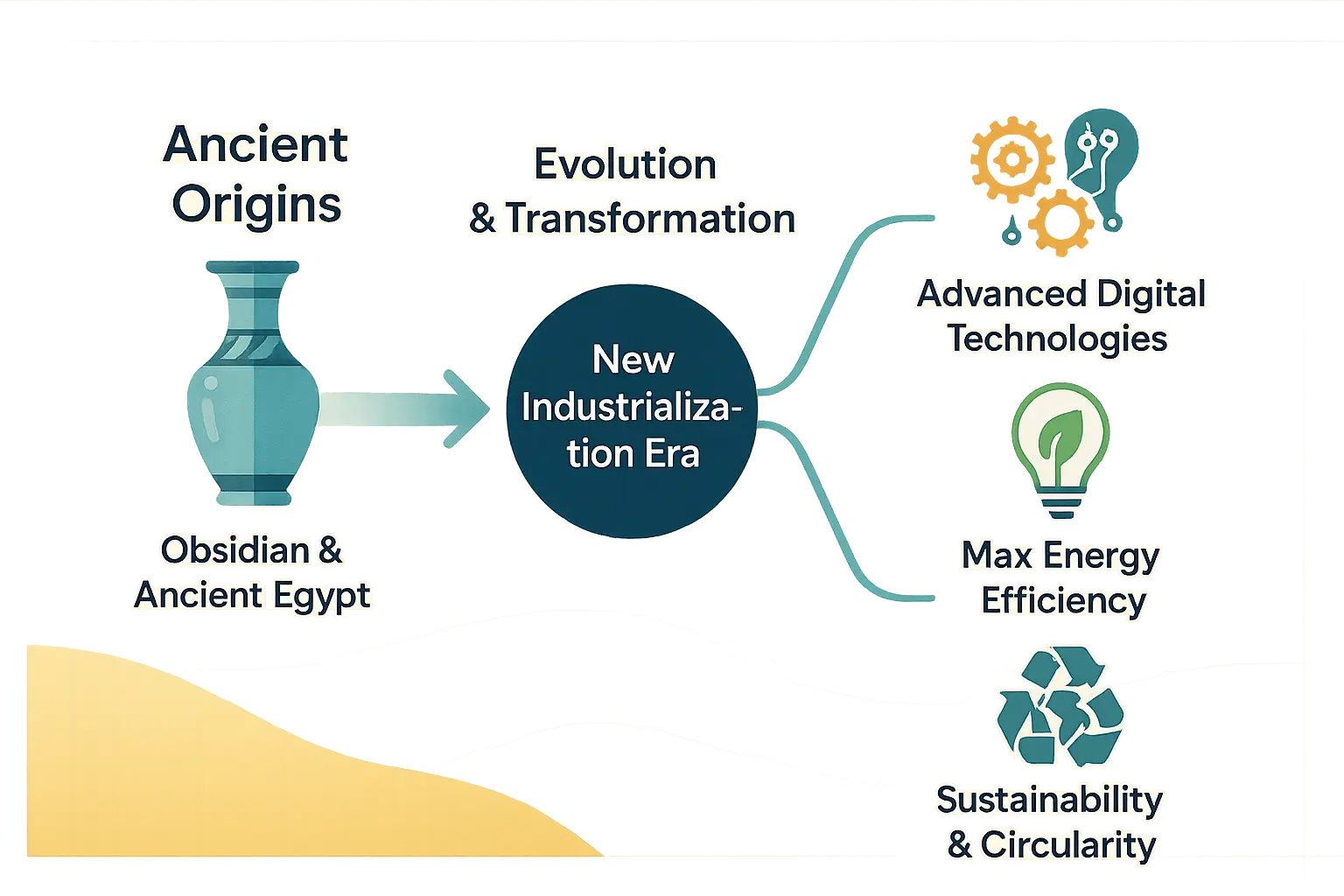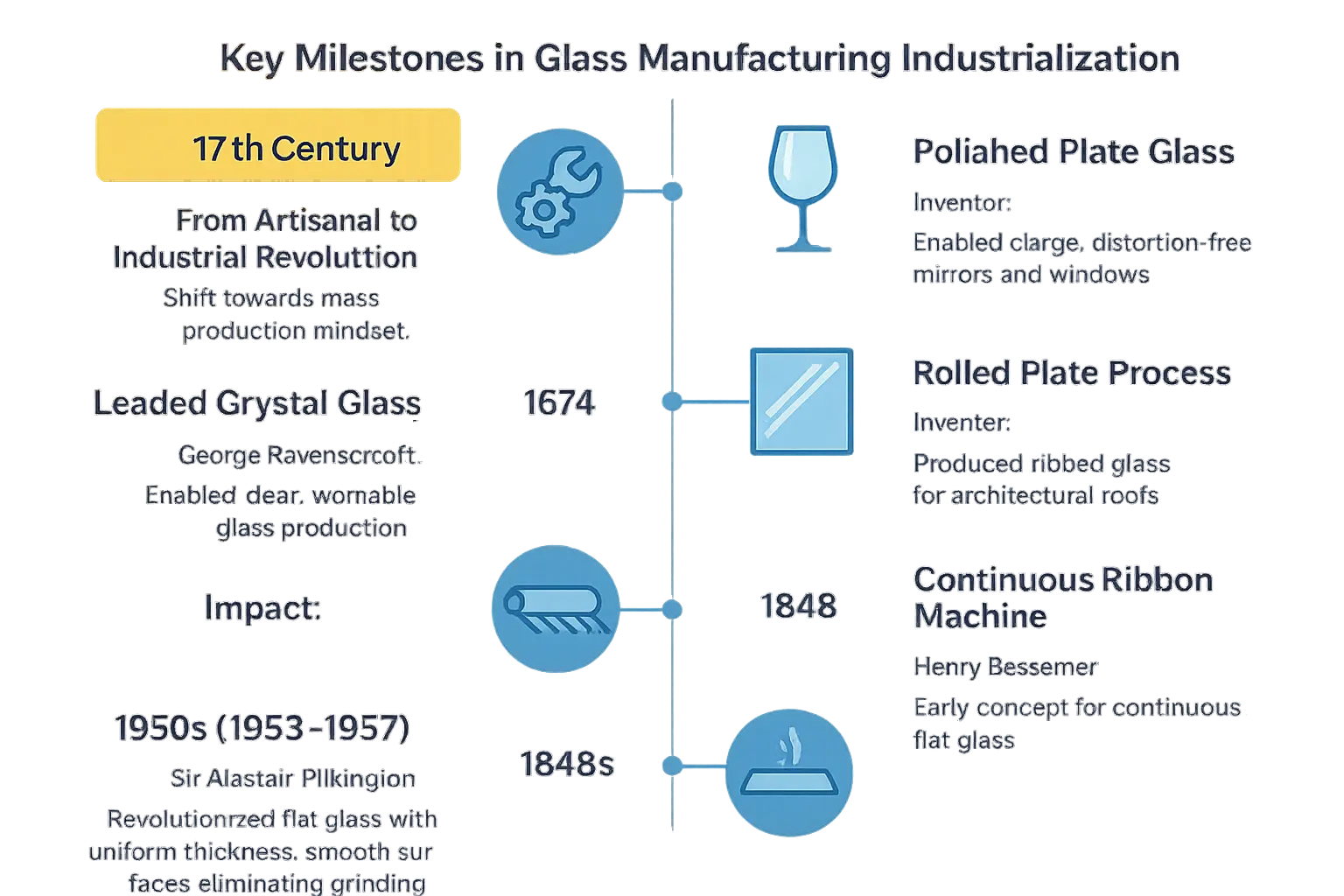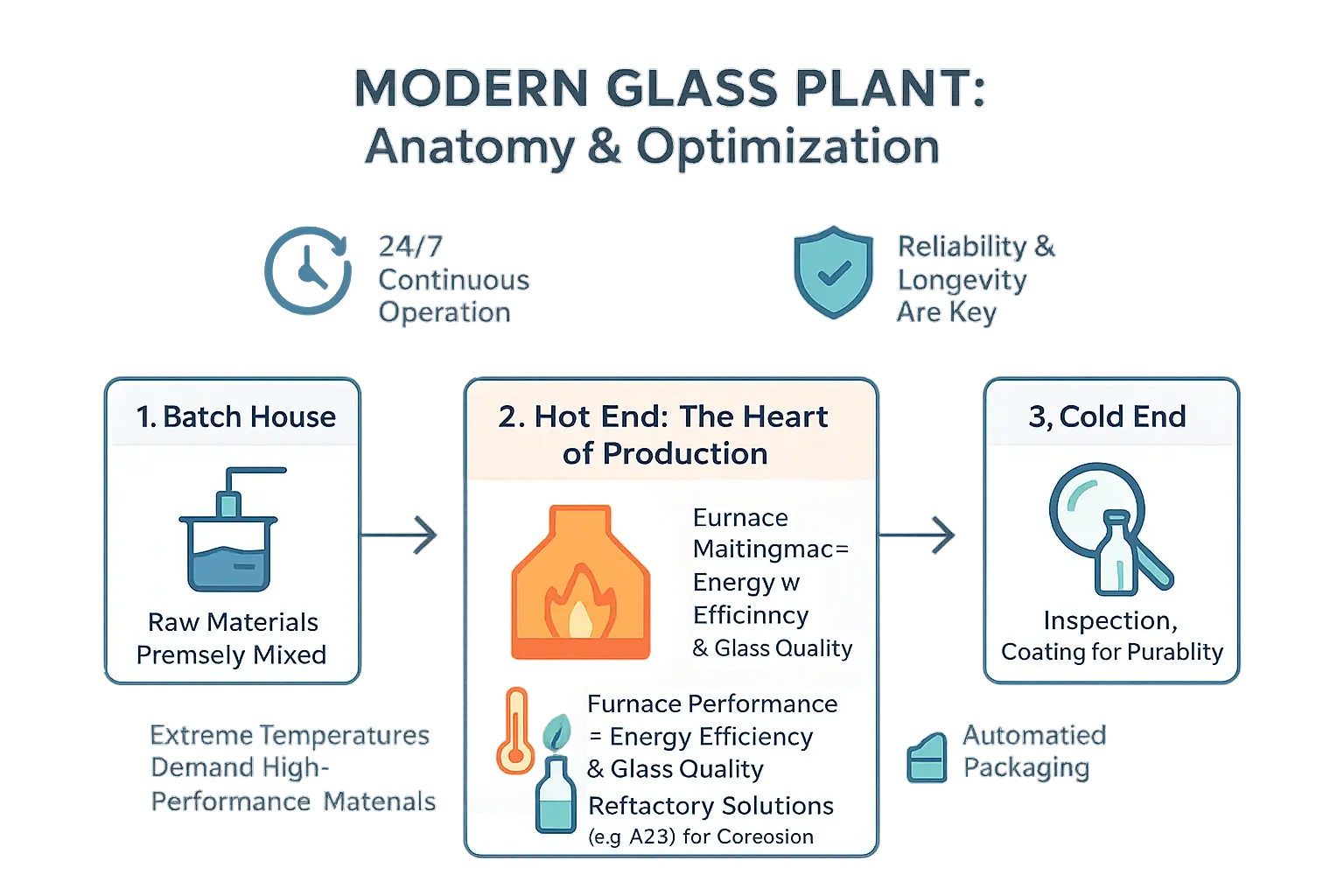Struggling with outdated glass manufacturing methods that drain resources and stifle innovation? The glass industry new industrialization era is reshaping a 5,000-year-old craft through AI-driven smart factories, IoT-enabled predictive maintenance, and ultra-durable AZS refractories that withstand 1,600°C+ temperatures. This advanced manufacturing processes revolution slashes energy costs by 30-40%, enables sustainability via closed-loop recycling systems, and delivers breakthroughs like thermochromic glass that reduces building cooling needs. From Pilkington’s float glass legacy to AI-optimized furnaces predicting corrosion failures, this transformation meets Industry 4.0’s demands while solving age-old challenges of material longevity and operational uptime in 24/7 production environments.
- From ancient art to modern marvel: the glass industry’s new frontier
- Pioneering innovations: how the industrial revolution shaped glass production
- The anatomy of a modern glass plant: optimizing for performance and endurance
- The smart factory: how Industry 4.0 is redefining the glass industry
- Beyond transparency: advanced glass and the drive for a circular economy
- Navigating the future of glass manufacturing
From ancient art to modern marvel: the glass industry’s new frontier
The glass industry, rooted in ancient craftsmanship, now enters a transformative era. From manual crown glass techniques to Industrial Revolution innovations like lead crystal, it now faces urgent demands for decarbonization while expanding specialized product capabilities. Traditional methods required artisans to spin molten glass into sheets—a stark contrast to today’s data-driven production lines operating 24/7 in energy-intensive environments.

Responsible for 2.6% of global industrial CO₂ emissions, the sector must adopt advanced processes. Hybrid electric furnaces, like Libbey Glass’s, leverage renewable energy for 60% CO₂ reductions. Industry 4.0 technologies—AI-driven control, predictive maintenance—optimize energy use in facilities avoiding furnace shutdowns. Smart sensors monitor temperatures at ±0.5% precision, minimizing waste during high-temperature operations (up to 1500°C).
Sustainability is non-negotiable. Initiatives like “Close the Glass Loop” target 90% European recycling rates, improving cullet reuse. Higher recycling rates cut virgin material use, reducing energy consumption by 2-3% per 10% recycled content. Digital twins and smart factories enable circularity. Leaders like Saint-Gobain merge automation with carbon-neutral strategies, balancing profitability and environmental goals.
This era unites tradition with innovation. Silicon-controlled rectifiers (SCRs) boost furnace precision, while cloud platforms streamline supply chains. The glass industry’s evolution—from ancient craft to data-driven manufacturing—proves energy-intensive sectors can create sustainable futures. Technologies like hybrid furnaces and AI-driven analytics now redefine efficiency in legacy systems.
Pioneering innovations: how the industrial revolution shaped glass production
The glass industry’s transformation began in the 17th century, shifting from artisanal techniques to mechanized mass production. This evolution redefined glass’s quality, accessibility, and role in modern infrastructure.
George Ravenscroft’s 1674 invention of lead crystal marked a turning point. By adding lead oxide, he created a denser, clearer product with superior refractive qualities. This established England as a glassmaking leader, reducing reliance on Venetian imports. Early “crizzling” issues were resolved by 1676 through formula refinement, with Ravenscroft using a raven’s head seal to identify his premium product. By the 1700s, drinking vessels saw a 75% price drop, democratizing high-quality glassware.
| Innovation/Process | Inventor/Developer | Approximate Era | Key Impact |
|---|---|---|---|
| Leaded Crystal Glass | George Ravenscroft | 1674 | Enabled industrial production of clear, workable glass |
| Polished Plate Glass | Louis Lucas de Nehou & A. Thevart | 1688 | Allowed creation of large, distortion-free mirrors and windows |
| Rolled Plate Process | James Hartley | 1847 | Enabled ribbed glass for architectural applications |
| Continuous Ribbon Machine | Henry Bessemer | 1848 | Laid groundwork for continuous flat glass production |
| Float Glass Process | Pilkington | 1950s | Revolutionized flat glass with uniform thickness and smooth surfaces |
In 1688, France’s Louis Lucas de Nehou and A. Thevart perfected cast plate glass, enabling large-scale mirror production. By the 19th century, steam-powered grinding and polishing transformed glass into an architectural staple. The Crystal Palace’s 1851 construction, featuring 900,000 square feet of glass, epitomized this shift, proving glass’s structural potential.
Early automation attempts, like Henry Bessemer’s 1848 continuous ribbon machine, faced limitations. While his roller-based concept was visionary, post-production polishing made it cost-prohibitive. Bessemer’s 1843 floating glass experiment foreshadowed future methods but lacked commercial viability then.
The true revolution came in the 1950s with Pilkington’s float glass process. By floating molten glass on molten tin, perfectly flat sheets were produced without grinding. This eliminated 20% material waste from polishing and reduced production costs by 30%, making standardized window glass affordable globally. Operating continuously 24/7, the process became the industry standard.

From Ravenscroft’s chemical breakthroughs to Pilkington’s metallurgical genius, these milestones laid the foundation for modern high-performance refractory solutions. Companies like mxs-refractories.com build on this legacy, using advanced materials to optimize energy-intensive glassmaking. The industry’s journey—from coal-fired furnaces to sustainable innovation—showcases how historical ingenuity continues to drive progress.

The anatomy of a modern glass plant: optimizing for performance and endurance
Modern glass manufacturing facilities operate in relentless 24/7 cycles, driven by the physical impossibility of safely restarting massive furnaces once production stops. This unyielding operational rhythm creates unique engineering challenges, particularly in maintaining equipment integrity under extreme thermal stress. Three core zones define these industrial ecosystems:
- Batch house: Where key raw materials are precisely mixed before being sent to the furnace.
- Hot end: The heart of the operation, containing the furnace for melting, forming machines, and annealing ovens. This is where extreme temperatures demand high-performance materials.
- Cold end: The final stage for inspection, coating treatments for durability, and automated packaging.
The hot end: where chemistry meets engineering
The glass furnace represents the technological pinnacle of any facility. Operating at temperatures exceeding 1,500°C, these furnaces require precise thermal control and material science mastery. Energy consumption patterns reveal startling realities: French glass production alone generates 2.8 million metric tons of CO2 annually, underscoring the critical importance of energy efficiency innovations.
Modern solutions like oxy-fuel combustion systems demonstrate remarkable progress. By replacing air with pure oxygen in the combustion process, these systems reduce nitrogen oxide emissions by 80% while improving thermal efficiency. O-I France’s Vayres facility achieved annual CO2 savings of 5,018 metric tons through such upgrades, proving the tangible benefits of advanced furnace engineering.
Refractory solutions: the unseen heroes of glass production
Inside these infernal environments, refractory solutions determine both product quality and operational economics. The furnace lining – typically combining dense hot-face bricks with insulating layers – must withstand three simultaneous assaults: thermal cycling exceeding 1,000°C gradients, corrosive alkali vapors, and mechanical erosion from molten glass flow.
Material selection becomes a strategic decision. Silica bricks with 94%+ SiO2 content maintain structural integrity at 1,600°C but struggle with corrosion resistance. High-alumina bricks (46%+ Al2O3) offer superior chemical stability but require precise porosity control to prevent glass infiltration. The most advanced installations now specify AZS refractories (Alumina-Zirconia-Silica) for critical zones, combining 50-70% Al2O3 with 20-40% ZrO2 to create materials capable of withstanding 1,700°C while minimizing glass contamination.
Material science meets operational reality
The choice between AZS grades (33%, 36%, or 41% ZrO2) depends on specific erosion profiles. Standard applications use 33% ZrO2 bricks for pool walls and parapets, while 41% variants protect high-wear zones like liquid outlets. This strategic material mapping directly impacts campaign longevity – properly specified refractories can extend furnace life beyond 10 years, though typical cycles range between 2-4 years depending on operational intensity.
Thermal insulation strategies complete the efficiency equation. Ceramic fiber modules with thermal conductivity below 0.045 W/m·K create protective barriers, while microporous boards with nano-silica structures reduce heat loss by 30% in space-constrained areas. These innovations don’t just conserve energy – they create safer working environments by lowering ambient temperatures in manufacturing zones.
The smart factory: how industry 4.0 is redefining the glass industry
Imagine a glass manufacturing plant where furnaces self-optimize energy use, robots handle hazardous tasks, and defects are detected at microscopic levels—all in real time. This isn’t science fiction; it’s Industry 4.0 reshaping a sector once defined by manual craftsmanship and high energy consumption.
At the core of this transformation lies the smart factory, integrating IoT sensors across production lines. These sensors monitor critical parameters like furnace temperatures (up to 1,600°C), pressure fluctuations, and chemical compositions at 100+ data points per second. For instance, real-time tracking of molten glass viscosity ensures consistent material quality, reducing waste by up to 15% compared to legacy systems.
Artificial Intelligence (AI) turns these data streams into actionable insights. Machine learning models predict optimal melting cycles, adjusting burner ratios to cut energy use by 8-12%. In one case, SymphonyAI Industrial’s Performance 360™ system reduced fuel costs by $1-3 million annually for a 60 TPD plant by forecasting refractory wear and optimizing furnace airflow. Such systems also anticipate process deviations, correcting them before defects occur—a leap beyond traditional quality control.
Maintenance strategies have shifted from reactive to predictive maintenance. By analyzing vibration patterns and thermal imaging, AI identifies refractory degradation months in advance. This prevents catastrophic failures like those costing up to $500,000 per unplanned shutdown. For example, Stara Glass’s predictive analytics extend furnace lifecycles by 20%, directly addressing preventing common refractory failures through early intervention.
Automation now spans production, inspection, and logistics. Robots like the Motoman UP20-6 handle raw material handling, while Fanuc’s vision systems inspect 3,600 glass sheets hourly, catching defects invisible to humans. In logistics, ABB’s palletizing robots stack 1,200 containers per hour with 99.98% accuracy, eliminating repetitive labor and reducing workplace injuries by 70% in high-heat zones.
- Enhanced efficiency: Real-time process optimization reduces energy consumption and raw material waste.
- Improved quality control: Automated inspection systems detect defects invisible to the human eye, ensuring higher product consistency.
- Increased operational uptime: Predictive maintenance minimizes unplanned shutdowns, a critical factor for continuous-flow industries.
- Greater safety: Robots handle dangerous tasks, reducing human exposure to extreme heat and machinery.
The transition isn’t without hurdles. Integrating 30+ legacy systems from different vendors into a unified data platform requires standardized tagging protocols—a challenge 60% of manufacturers face. Yet, solutions like centralized industrial data lakes and edge computing gateways are closing this gap, enabling seamless AI-driven analytics.
Digital twins now simulate entire production lines using 10,000+ variables, from raw material humidity to burner pressure. These virtual replicas predict outcomes with 98% accuracy, guiding adjustments in real-time. For example, a digital twin can forecast furnace oxygen levels 72 hours in advance, preventing quality drops during shifts in natural gas composition.
The economic impact is tangible. Plants adopting Industry 4.0 report 25% faster production cycles and 30% lower reject rates. With energy accounting for 40% of production costs, AI-optimized processes are critical for meeting sustainability targets. The glass sector’s roadmap includes full electrification of furnaces by 2040—a goal only achievable through the precision of digital technologies.
As robotics handle 80% of repetitive tasks, workforce roles evolve toward data analysis and system oversight. Germany’s SME 4.0 Centers already train 5,000 workers annually in these skills. The future belongs to factories where human expertise and machine intelligence coexist—crafting a smarter, more sustainable glass industry.
Beyond transparency: advanced glass and the drive for a circular economy
The glass industry is transforming through specialized product development and digital technologies. While manufacturing evolves, materials like smart glass redefine functionality across sectors. This shift merges technical innovation with environmental goals, using IoT sensors and AI analytics to optimize energy use and reduce waste. For instance, sensors embedded in smart glass can detect sunlight intensity and adjust tint dynamically, cutting HVAC loads by up to 30% in commercial buildings like Amsterdam’s Edge office—showcasing how real-time data drives efficiency.
Advanced glass applications include:
- Architectural glass: Electrochromic glass cuts building energy use by up to 20%. The Edge office’s smart glass system, paired with solar panels, achieves 70% energy savings compared to conventional skyscrapers.
- Automotive & Aerospace: Ultra-thin Gorilla Glass, as in BMW’s iX SUV, reduces vehicle weight by 15% while enhancing durability. In aerospace, Boeing’s 787 Dreamliner uses smart windows that eliminate traditional mechanical shades, improving passenger comfort and fuel efficiency.
- Electronics: Samsung’s Ultra Thin Glass withstands over 200,000 folds in devices like the Galaxy Z Fold4. Future applications include rollable tablets and e-paper displays for retail signage, reducing plastic waste.
- Energy: Photovoltaic glass generates electricity in structures like Barcelona’s Solar Light House, integrating aesthetics with power production. Recent advancements in perovskite solar cells now achieve 25% efficiency in transparent glass, rivaling traditional panels.
Material innovation alone isn’t sufficient—circular economy principles must address production and end-of-life challenges. Recycling is critical: using cullet (recycled glass) cuts energy consumption by 30% and avoids 1.2 tons of CO₂ per ton used. Yet contamination from ceramics or miscolored glass disrupts streams, with only 40% of U.S. curbside glass processed successfully. Even 1% impurities can render food-grade batches unusable, highlighting the need for better consumer education.
Innovations are tackling these barriers. Closed-loop systems now enable infinite recycling without quality loss. High-performance refractory linings, like silicon carbide, extend furnace lifespans by 25%, reducing downtime and energy use by 8% per melt cycle. Digital twins—virtual replicas of furnaces—optimize temperature profiles, lowering defects. AI-powered sorting robots, such as ZenRobotics’ systems, identify glass by color and material type with 98% accuracy, slashing contamination rates.
Initiatives like Close the Glass Loop aim to raise European glass collection rates to 90% by 2030. This requires collaboration: manufacturers like Owens-Illinois invest in mono-material packaging, while cities like Amsterdam mandate separate glass collection bins. Blockchain platforms like Circulor now track cullet from dumpsters to factories, ensuring transparency in closed-loop systems.
By integrating Industry 4.0 technologies—from AI analytics to automated sorting—the sector balances smart glass innovation with sustainability. Breakthroughs like self-healing coatings (which use microcapsules to repair scratches) and bio-based additives for easier glass recycling demonstrate how the industry is redefining its role in a resource-efficient future. As refractory materials improve furnace efficiency and digital tools optimize recycling, glass transitions from a traditional material to a leader in advanced glass and circular economy innovation.
Navigating the future of glass manufacturing
The glass industry stands at the intersection of tradition and innovation. From 17th-century lead-crystal breakthroughs to modern float glass processes, this sector has consistently embraced technological leaps. Today, digitalization reshapes production through smart factories, real-time energy monitoring, and predictive maintenance systems that reduce downtime by up to 30%.
Sustainability drives this evolution. With glassmaking responsible for 95 million annual CO2 tons globally, companies like Saint-Gobain and Guardian Glass demonstrate tangible progress through hybrid furnaces and energy management systems that cut costs by 4% monthly. Digital twins now simulate furnace operations with 99.98% accuracy, optimizing both output and environmental impact.
Emerging technologies redefine possibilities: self-healing glass with molecular repair capabilities, transparent solar panels integrating into skyscrapers, and ultra-thin glass enabling foldable electronics. These aren’t sci-fi concepts but active R&D priorities across 78% of leading manufacturers.
For industrial leaders navigating this transformation, partnering with specialized experts becomes critical. MXS Refractories supports global clients in implementing high-performance refractory solutions that enhance furnace efficiency while meeting sustainability targets. To future-proof your glass manufacturing operations, contact our team for tailored refractory design and on-site optimization strategies.
The glass industry’s new industrialization era merges digitalization, product innovation, and sustainability. Embracing smart technologies and refractory expertise, this evolution isn’t futuristic—it’s now. Prioritize efficiency and circular practices to lead. Partner with specialists to future-proof your operations. [Contact MXS Refractories](https://mxs-refractories.com/contact/) for tailored solutions.
